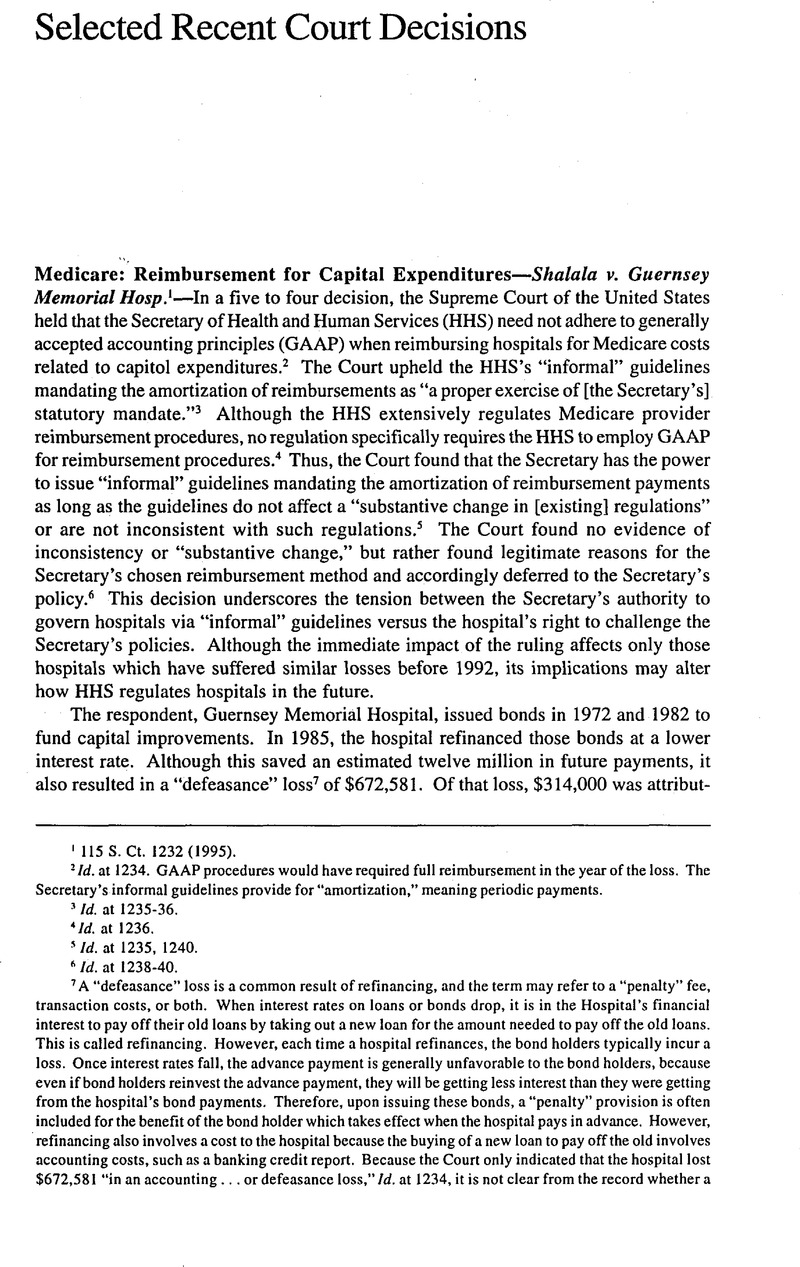No CrossRef data available.
Published online by Cambridge University Press: 24 February 2021

1 115 S. Ct. 1232(1995).
2 Id. at 1234. GAAP procedures would have required full reimbursement in the year of the loss. The Secretary's informal guidelines provide for “amortization,” meaning periodic payments.
3 Id. at 1235-36.
4 Id. at 1236.
5 Id. at 1235, 1240.
6 Id. at 1238-40.
7 A “defeasance” loss is a common result of refinancing, and the term may refer to a “penalty” fee, transaction costs, or both. When interest rates on loans or bonds drop, it is in the Hospital's financial interest to pay off their old loans by taking out a new loan for the amount needed to pay off the old loans. This is called refinancing. However, each time a hospital refinances, the bond holders typically incur a loss. Once interest rates fall, the advance payment is generally unfavorable to the bond holders, because even if bond holders reinvest the advance payment, they will be getting less interest than they were getting from the hospital's bond payments. Therefore, upon issuing these bonds, a “penalty” provision is often included for the benefit of the bond holder which takes effect when the hospital pays in advance. However, refinancing also involves a cost to the hospital because the buying of a new loan to pay off the old involves accounting costs, such as a banking credit report. Because the Court only indicated that the hospital lost $672,581 “in an accounting ... or defeasance loss,” Id. at 1234, it is not clear from the record whether a “penalty” provision had anything to do with that loss. See id. However, respondent's brief confirms that the refinancing cost a “penalty” or “call premium” of $300,000. Other costs included bond underwriter discounts, attorney and accountant fees, and feasibility study costs.
8 Id. at 1234.
9 Id. at 1234-35.
10 Id. at 1235.
11 Id. at 1235-37.
12 Id. at 1235-36.
13 Id. at 1236.
14 Id.
15 Id.
16 Id.
17 Id.
18 Id. at 1236-37.
19 Id. at 1237-38.
20 Id. at 1239.
21 Id. at 1238 (citation ommited).
22 Id. at 1239.
23 Id.
24 Id. at 1238.
25 Id.
26 Id.
1 44 F.3d 715 (9th Cir. 1995).
2 Id. at 720-21.
3 Id. at 718.
4 Id. at 721.
5 Id. at 717-18, 720.
6 Id. at 717-18.
7 Id. at 718.
8 Id. at 719. See Doe v. Attorney General, 941 F.2d 780 (9th Cir. 1991) (holding that Dr. Doe was a “handicapped” individual within the meaning of the Act).
9 Id. at 719.
10 Id. at 720.
11 Id.
12 Id.
13 Id. at 720.
14 Id.
15 Id.
16 Id.
17 Id. Mill.
18 Id.
19 Id.
20 Id.
1 652 A.2d 1350 (Pa. 1995).
2 Id. at 1351.
3 Id.
4 Id. at 1353-55.
5 Id. at 1356-58.
6 Id. at 1351.
7 Id. at 1352.
8 Id. at 1352-53.
9 497 U.S. 261 (1990).
10 In re Fiori, 652 A.2d at 1353-55.
11 Id. at 1355.
12 Id. at 1355-56.
13 Id. at 1356 (quoting Matter of Jobes, 529 A.2d 434, 444 (N.J. 1987)).
14 Id.
15 Id. at 1356-57.
16 Id. at 1357.
1 452 S.E.2d 589 (N.C. App. 1995).
2 Id. at 594.
3 Id.
4 Id. at 593.
5 Id.
6 Id. at 594.
7 Id.
8 Id.
9 Id.
10 Id.
11 Id. at 595.
12 Id.
13 Id.
14 Id. at 596.
15 Id.
1 855 F. Supp. 137 (E.D.Va. June 16, 1994).
2 Id. at 137.
3 Id. at 142.
4 Id.
5 Id. at 144.
6 Id. at 140.
7 Id.
8 Id.
9 Id. at 139-40.
10 Id. at 141-43.
11 Id. at 141-42.
12 Id. at 141.
13 Id. at 142.
14 Id.
15 Id.
16 Id.
17 Id. at 143.
18 Id.
19 Id.
20 Id.
21 Id.
22 Id. at 144. The religious Freedom Restoration Act of 1993 states that the government cannot “substantially burden a person's right to exercise of religion” unless it uses a narrowly tailored statute to protect a compelling governmental interest. 42 U.S.C. §§ 2000bb(b)(2).
23 See Reno, 855 F.Supp. at 144.
24 Id.
25 Id.
26 Id.
1 49 F.3d 586 (9th Cir. 1995).
2 Id. at 588.
3 Id. at 590-94.
4 Id. at 590-92.
5 Id. at 593.
6 Id. at 589.
7 Id.
8 Id. at 589-90.
9 Id. at 590.
10 Id.
11 Id. at 590-91.
12 Id. at 590.
13 Id. at 590-91.
14 Id. at 590.
15 Id. at 591.
16 Id.
17 Id.
18 Id. at 592.
19 Id. at 591.
20 Id. at 593-94.
21 Id at 593.
22 Id. at 594.